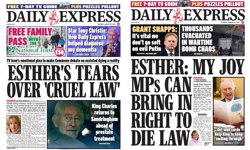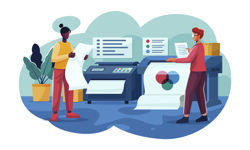Tower Publishing Services (TPS), one of the UK’s leading fulfilment bureau, has invested heavily in online development and has seen a dramatic increase in the use of email marketing and online ordering of subscriptions and controlled re-registrations. In November 2003 TPS took 26,583 subscription orders over the web compared to approximately 4,000 for November 2001 – an increase of over 500%.
B2B leads the way
Whilst there has been growth in usage across the whole magazine sector it is particularly marked in the b2b sector, especially in the area of controlled circulation. According to Chenevix Trench "b2b was the early adopter and continues to lead the way". He adds that "the significant growth in the b2b sector really happened eighteen months ago as the benefits of email marketing and online registration began to be realised. Since then, publishers in this sector have gone for it "hammer and tongs" and it is now considered THE central part of most circulation strategies." This is partly due to the much greater success the b2b sector has had in the capture of email addresses through the registration and re-registration process. They have been "without exception very successful" although, even within the b2b sector there are shades of performance. Magazines aimed at desk bound, computer literate, internet savvy audiences do very well, whilst those aimed at more mobile groups of workers do less well. At the top end of the performance ladder, Chenevix Trench is seeing 55-60% response rates to a single re-registration email blast, whilst at the bottom end it is more likely to be 15%.
Usage of email marketing in the consumer sector lags some way behind. There are two main reasons for this. First and foremost is the lack of email addresses held on the reader files. Chenevix Trench estimates that the average consumer address file has 10-30% of records with email addresses. Again there will be variations and consumer titles dealing with IT matters will have much higher percentages. The other major factor is the increasing use of direct debit as a payment method. Most consumer publishers are promoting it heavily and Chenevix Trench estimates that most consumer titles have 35-55% paying by direct debit. With the increasing use of DD the whole "email vs traditional method" debate becomes somewhat academic since obviously direct debit payers do not need to be contacted for renewal. For consumer publishers it is only the cash-with-order subscribers for whom this is an issue and because of the relatively small numbers, the cost savings to be gained through email marketing are less pronounced.
Improve address capture
Due to the cost and immediacy benefits of email marketing it is in both consumer and b2b publishers’ interests to maximse the number of usable email addresses they hold. There are a number of practical steps publishers can take to help achieve this. Believe it or not some publishers are still not asking for email address on subs and registration forms. It is never to late to join the 21st Century, so for the select few still holding out, I would recommend that you at least start asking the question. Who knows? You might one day find a use for it. A much larger group of publishers ask the question, but obviously are not that bothered whether anyone answers it. I say that because they persist in leaving an approximate one inch space for people to write their email addresses. Even those readers who are prepared to give it a go, are unlikely to be able to leave anything legible in the space allowed. How much space should be left? Try it out yourself – take your form and fill it in. Assuming your own email address is of fairly average length then this should give you the answer.
Both of the above scenarios suggest publishers who are not that bothered about email addresses. For those that do put the question on the form and do leave enough space, there are a few simple things you can do. Chenevix Trench suggests one solution:– on the form, move the email line up, so that it appears just under the reader name line. Putting it there gives the reader less time to question its purpose and hence they are more likely to fill it in. Another technique for increasing email address capture is to create "email capture" web sites and then direct readers to them. For instance you might put the following message on your carrier sheet: "if you would like us to direct future correspondence to you by email then go to the following web site and leave your email address." On the web site will typically be three boxes: the first for the reader’s account number, the second for the email address and the third a "confirm email" box. Lastly, there are a few basic data validation techniques which will help increase the percentage of usable addresses you have on file: these include: ensuring that the address is no shorter than five characters, that the data string contains an @ symbol and no commas. If the reader is inputting the data online then a "confirm email address" box will also reduce errors.
Probably the best way of capturing email addresses is to promote the web as the best place for people to subscribe or renew and to then make the email address box a mandatory field. Increasingly publishers are directing people to the web. Typically the traditional hard copy renewal series will present "pay online" as the first payment option on the remittance slip.
It is very easy to get carried away by the cost savings and perceived ease-of-use of email and Chenevix Trench advises caution. The benefits "tend to cloud people’s minds so that instead of very clear DM principles, where any expenditure is accompanied by testing elements of the offer, "package", creative, copy, price etc etc subs email marketing is too frequently created last minute with no focus on testing." Attention to copy is vital and he advises that you tailor your message to the medium and do not simply replicate the text of your hard copy offer onto your email. The immediacy of the medium means that a "your subscription is about to expire" message will get a swift reply of "oh no it’s not" unless it really is! Setting up an email series requires different skill sets to that required for traditional direct mail and there is a greater emphasis on IT support; for instance the links within the email have to be properly constructed. Whilst email "is undoubtedly far less expensive than direct mail, there needs to be an understanding of the processes involved."
The primary purpose of all these email renewal / re-registration broadcasts is to get the reader to click on the hyperlink embedded in the email to take them to a web interface – a web page with the look and feel of the magazine. There the reader will have his / her current delivery address and subscription details displayed along with options to edit and renew. On submission this data is then transmitted back to the bureau (or direct to the publisher if they manage their circulation in-house) where usually a number of manual checks will be made before the data is merged in with the live file. In TPS’s case the lead time from submit to database update is approx 15 minutes. This means that subscriptions are starting to be renewed and the database updated within 20 minutes of the broadcast going out. Compare that with the cost and lead time of the traditional direct mail route and you can see the reasons for the exponential growth in email broadcasting as a renewals tool.
Avoid complicating the message
So in this bright new world of email marketing is there a downside? Chenevix Trench advises against seeing email as the panacea to everything. A realistic assessment of its strengths and weaknesses should be made and an integrated strategy arrived at. One common pitfall is to get too carried away by the perceived cross selling opportunities presented by the medium. From a "purely direct marketing standpoint you need to be wary of complicating the message" with too many pop up windows and myriad special offers. Also be clear about what you are trying to do. If your purpose is to secure a renewal then the hyperlink should take the reader direct to his record and the renew options with an absolute minimum of interference. A hyperlink to the main home page (perhaps with a secondary purpose of maximising website hits in mind) and then relying on the reader to navigate their way through your site will fail. The moment will pass and it is just too easy for the reader to click away.
Email is particularly successful for renewals but is notably less successful at new subscription generation. Where you need to expand on the proposition, perhaps with the use of eye catching visuals then a hard copy format is possibly more successful. Beyond that, the new data protection legislation introduced last December will make it virtually impossible to email cold lists. This presages the start of the direct mail fightback.
To summarise: email marketing is here to stay and gives real benefits in the areas of renewals and re-registrations. Publishers need to put more thought into their procedures for capturing email addresses and into developing integrated strategies to fully utilise both email / on-line and also the more traditional forms of circulation marketing.
| Crystal Ball You would have to be a brave man to predict the future role and usage of email broadcasting in publishing in five years time, but based on my chat with Angus I am going to do just that: here are my four predictions: 1. The ever increasing use of direct debit in the consumer sector will mean that an ever decreasing number of subscribers will need to be renewed at all. Of those that do, the majority will be contacted and will renew electronically without recourse to hard copy. A small rump will still need to be renewed by post or by phone. 2. In the b2b paid sector, due to the relatively low take up of direct debit and the need for audit trails and accounts department involvement in the buying process, the majority of renewal reminders will be by email but the payment and remittance process will still be paper based. 3. The b2b controlled sector will be 95% electronic with a combination of letter / phonecall to hoover up the awkward squad. 4. The more traditional forms of marketing – direct mail and telemarketing – will be concentrated largely in the new subscriber acquisition sphere where they can play to their strengths and where, in any case, data protection legislation will have rendered email marketing largely unusable. |










